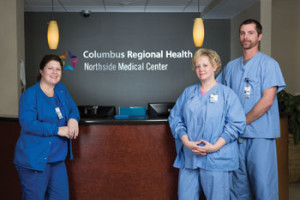June 17, 2014. Any of the 2,700 employees of Columbus Regional Health (CRH) could likely tell you the significance of that date. At midnight, employees discharged patients from one electronic health record (EHR) system and readmitted them to a new one. Seven IT systems were replaced by one integrated core system inclusive of the EHR, patient accounting, general accounting, supply chain, and the clinical support systems of Pharmacy, Laboratory and Imaging.
Along with switching to a new information platform, the Columbus, Georgia-based system also went live with sweeping changes that included transforming the revenue cycle, revamping supply chain processes, strengthening clinical value analysis and renegotiating pricing on purchased services.
The changes, done in partnership with HealthTrust and Parallon, resulted in $5 million in guaranteed savings in the first year, and an additional $30 million in projected savings in supply chain and purchased services over the next four years. There is also a projected $19 million savings over 10 years for EHR-related implementations.
On the Fast Track
Best practices may dictate that comprehensive changes be implemented in phases, but that simply wasn’t an option for CRH. The nonprofit system, which grew from one hospital to three in 2008, was facing a multitude of challenges. The years 2011 through 2013 all ended with losses for the system. Despite becoming part of the same system in 2008, the two newly purchased hospitals were operating in silos, using separate EHR platforms and different GPO agreements.

“We had never acted like a health system,” says Meredith Bass, director, corporate finance for CRH. “We didn’t share resources. We didn’t share best practices. Everyone was doing their own thing, right down to ordering their own Band-Aids.”
Additionally, staff turnover was high, even at the leadership level, and there was no control over purchasing.
“There were no electronic invoice approval processes in place, and directors were able to execute their own contracts. They would just contract for and order whatever they wanted based on their individual department needs,” Bass says.
Overflow materials went into a stockroom in the basement, where they often expired or became obsolete as new and improved products were introduced.
Meanwhile, a looming Stage 1 Meaningful Use deadline was a stress for the system, which would result in the loss of incentive payments if it failed to meet the requirements by July 1, 2014. Leaders were also dealing with merging two hospitals under one license.
“The changes were so intricately connected that we decided it would have been even more costly and more painful to stagger the changes over six months to a year,” says Doug Colburn, vice president of operations at Midtown Medical Center, which makes up about 90 percent of CRH’s revenue and has a level 2 trauma designation. “Additionally, we really didn’t have time to do it any other way. We had to move to a lower cost structure, or we were in serious trouble. Our expense structure was not sustainable.”
Supply Chain Changes
System leaders knew that the best way to centralize the supply chain was to make all purchases through a single GPO. HealthTrust was already operating a committed model at two CRH facilities; a cost analysis suggested a wholesale switch to HealthTrust for the entire system would be financially savvy. The move was expected to save Midtown Medical Center a minimum of 10 percent on its supply expenses.
From there, HealthTrust helped the system find additional efficiencies, becoming a total cost management partner that could bring solutions beyond just contract negotiations.
With a fresh approach to value analysis, HealthTrust helped supply chain leaders engage physicians in product selection and standardization initiatives. Three clinical resource experts were placed on-site to guide the program’s success. Since the beginning of 2015, value analysis activity has contributed to more than $3 million in savings, with an additional $3 million in the process of being implemented. The majority of the savings is on implantable devices, followed by commodities and then pharmaceuticals. An ongoing spine hardware initiative is projected to result in an annual $450,000 savings on $1.6 million in spend.
“Now with the new open bin point-of-use system, reorders happen automatically, and supplies are on a just-in-time (JIT) delivery schedule, four days a week.”
— Doug Colburn, vice president, operations, Midtown Medical Center
HealthTrust also helped implement an open bin point-of-use barcode scanning replenishment and charging system, where purchase orders and requisitioning across the system are processed using Parallon’s proprietary materials management system. As a result of these changes, there was a decrease of 37 percent in full-time-equivalent staffing due to a 90 percent reduction in on-site physical inventory.
“Labor costs were much higher before the implementation of the new point-of-use system,” Colburn says. “Now with the new open bin point-of-use system, reorders happen automatically, and supplies are on a just-in-time (JIT) delivery schedule, four days a week.”
Bass says such a dramatic reduction in inventory has additional financial benefits for the system. There are fewer write-offs for unused, outdated or expired product waste, and the process for the annual inventory count following generally accepted accounting principles has been streamlined. “With a lot less product here, we spend less time taking inventory,” she says.
Another big initiative for CRH was in purchased services. Across 22 categories, the system has saved more than $1.2 million, with significant savings in HVAC services (49 percent), linen services (31 percent) and scope/instrument repair (25 percent).
Plan for Success
While the information platform changes all went live on a single day, preparations to ensure everything went smoothly took close to a year. Due to significant cultural and operational change, morale was low and there was a lack of confidence in the project, making the roles for Colburn and Bass even more difficult.
“We let staff members know that instead of doing these conversions over a period of many years, we had to do them quickly and efficiently within a prescribed timeframe,” Colburn says. “Previous expectations had been that everything needed to be perfected before implementation. The new focus was to implement with a fixed scope on a specific timeline. We would then make adjustments through the continuous quality improvement process and find opportunities to make improvements post implementation.”
A command center was staffed with key personnel, including representatives from HealthTrust and Parallon. It was online 24/7 for 45 days after the go-live date to help with any challenges. In all, 358 team members, including more than 80 suppliers and contractors, were directly involved with the implementation of the project. Brandon Droz, then the director of supply chain operations at Parallon, was also on-site during the go-live period to lead the supply chain operational changes.
As the partnership enters its second year, Bass and Colburn say they continue to be impressed with the support from HealthTrust and Parallon. “One phone call to them, and they have boots on the ground to help,” Bass says. “That support and follow-through is really something they can hang their hat on.”
At press time, CRH was on track for its first profitable year in four years.
“I didn’t realize how broken our supply chain operation had been,” says Allen Butcher, executive vice president and chief financial officer of CRH. “Not only has this turnaround allowed us to return to profitability, but we also have a capital budget for the first time in a long time. There were a lot of contributing factors, but HealthTrust’s performance played a large role in making this happen.”
Share Email





